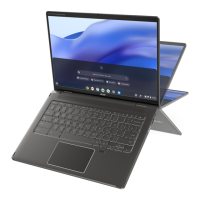Do you have a question about the Acer Chromebook Tab 10 and is the answer not in the manual?
Register your Acer product after receiving it to get confirmation email and important data.
Log onto account.acer.com using your Acer ID to manage registered products.
Press and hold the power button to turn on the Chromebook Tab.
Choose your default language and keyboard input method.
Connect to the internet by selecting a network and entering a password if needed.
Accept terms to download system updates and get the latest features.
Set up a new Google Account for access to Google services.
Use the Chromebook Tab without logging into a Google Account.
Enter your Google account username and password to sign in.
Details about the front view of the Acer Chromebook Tab, including camera and touchscreen.
Details about the rear view of the Acer Chromebook Tab, including camera and stylus pen.
Details about the top view of the Acer Chromebook Tab, including speakers, microphone, and jack.
Details about the left view of the Acer Chromebook Tab, including slots and buttons.
Details about the base view of the Acer Chromebook Tab, including speakers and USB Type-C port.
Information on USB 3.1 Gen 1, DisplayPort over USB-C, and power delivery specifications.
Explanation of window control buttons like back, forward, reload, and close.
Overview of the Chrome OS shelf, including launcher, pinned apps, and status area.
How to use the Launcher to search for items and access apps.
Instructions on pinning and unpinning apps to the shelf for quick access.
Function of the back button to exit fullscreen apps and menus.
Function of the overview button for split-screen multitasking.
Information on using the stylus, including its tools and functions like screen capture and note creation.
Explanation of icons in the status area for time, Wi-Fi, battery, settings, and shutdown.
Steps to find and install apps from the Chrome Web Store.
Steps to find and install apps from the Google Play Store.
Steps to uninstall applications from Chrome OS.
How to pin an application icon to the shelf for easy access.
How to remove an application icon from the shelf.
Information about Google Drive, online storage for files accessible on other devices.
Explains the distinction between Google Drive (cloud) and Files app (local storage).
Steps to create new documents using Google Docs, Sheets, or Slides.
Instructions to upload files from Downloads folder to Google Drive.
Steps to make Google Drive files available for offline access.
Steps to compose and send an email using Gmail.
Information on accessing and using YouTube for video sharing and viewing.
How to play audio and video files using the built-in media player.
List of file formats supported by the Chromebook Tab for documents, images, and compressed files.
Steps to create new documents using Google Docs, Sheets, or Slides.
How to locate documents saved in Google Drive.
Instructions for sharing Google Drive documents with others via email.
Steps to initiate a video chat using Google Hangouts.
Steps to access and play music using Google Play Music.
Instructions to watch videos on YouTube, Play Movies, or other streaming apps.
Guidance on handling Microsoft Office files on Chromebook.
How to open and edit Microsoft Office files with limited editing capabilities.
Steps to convert Microsoft Office files into Google Docs, Sheets, or Slides.
How to download Google Drive documents in Microsoft Office formats.
Using Microsoft Office Online apps for editing files.
Tips for using offline apps and staying productive without an internet connection.
Instructions for using Gmail in offline mode.
Important notes on using Google Drive offline and syncing changes.
Steps to change the system language and input methods.
How to adjust the time format and time zone on your Chromebook Tab.
How to change the desktop wallpaper by selecting preloaded or custom images.
How to find and apply browser themes from the Chrome Web Store.
Information on using Google Cloud Print to set up printers.
How Chrome OS updates automatically upon startup.
Steps to manually check for and install Chrome OS updates.
Instructions for resetting the Chromebook Tab to factory settings (Powerwash).
Information on accessing built-in Chromebook Help for troubleshooting and guidance.
| Operating System | Chrome OS |
|---|---|
| Display | 9.7-inch IPS LCD |
| RAM | 4GB LPDDR3 |
| Storage | 32GB eMMC |
| Wireless | 802.11ac Wi-Fi |
| Rear Camera | 5 MP |
| Front Camera | 2 MP |
| Processor | Rockchip RK3399 |
| Graphics | Mali-T860 |
| Bluetooth | 4.1 |
| Ports | USB-C |
| Battery | 34 Wh |
| Weight | 1.2 lbs |
| Stylus | Wacom EMR stylus (included) |



